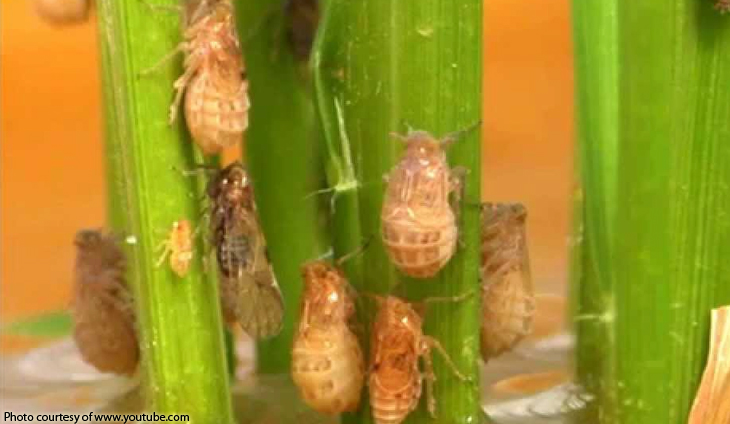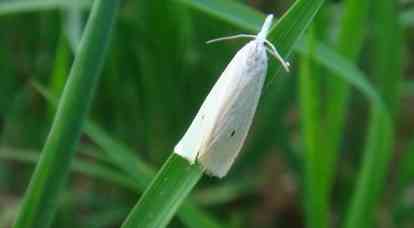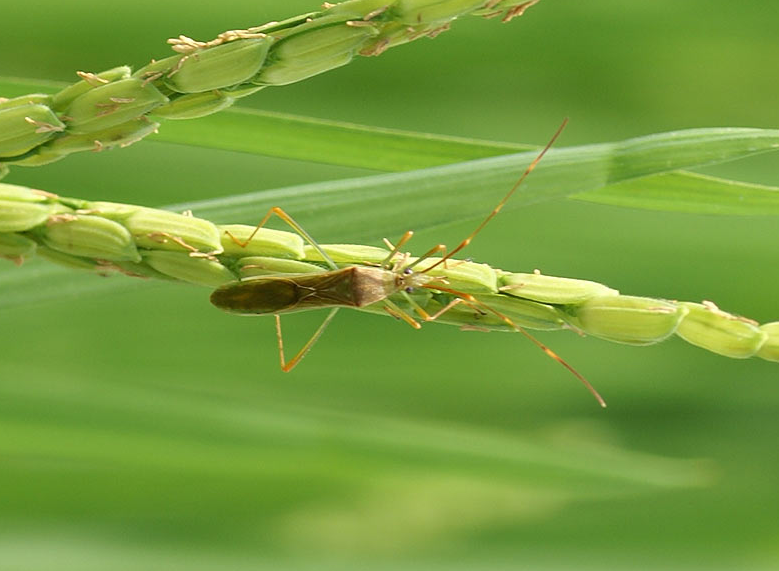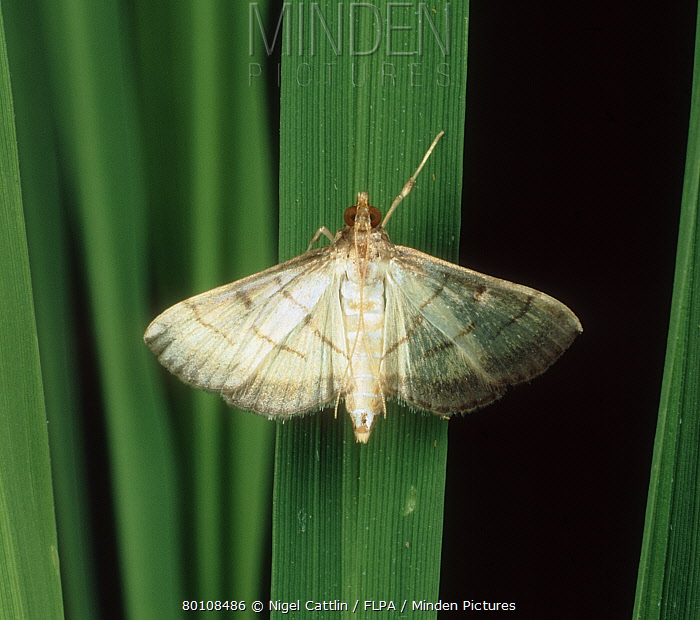1. Brown plant hopper - Nilaparavata lugens

Both nymph and adult feed on paddy by sucking cell sap. The nymphs are brownish in color and have grayish blue eyes. They lay eggs in mass by lacerating parenchymatal tissues. The eggs are somewhat cylindrical having two distinct spots.
Damage: Suck the cell sap from the leaves and the leaves turns yellow. A heavy infestation produces symptoms of ‘hopper burn’ i.e leaves become dry and brown after insect feeding and the infected plant often lodges in patches. Even tillering is adversely affected. High humidity, optimum temperature, high nitrogen application and no wind favors growth of BPH.
Management
- Maintain proper spacing
- Grow resistant varieties IR26, IR36, IR56, IR64, and IR72
- Alternate drying and wetting of the field and draining of the standing water.
- Spray monocrtophos 35 EC @ 2ml/l (78 ml/ropani) at nursery stage.
- Application of granular phorate 10G@ 0.5 kg/ropani or carbofuran 3G@ 1.2kg/ropani insecticides in presence of thin film of water.
- Spray imidacloprid 200 SL @ 0.5ml (15 ml/ropani) or thiomethaxm 25WG @ 0.5g (15kg/ropani) or phaslone 35 EC @ 2ml/l (100ml/ ropani) water or quinolphos 5G @ 1.5kg/ropani.
2. Yellow rice stem borer - Scirpophaga incertulas

They are dirty white or greenish yellow having brown head and pronotum. Female moth is bigger than the male and has a centrally situated black spot on each of the forewing also female has prominent tuft or brownish yellow silken hair at the tip of their abdomen. They lay eggs on the underside of the leaves. The eggs are covered with yellowish brown hair of the female tuft.
Damage: causes death of the central leaf whorl at the vegetative stage known as dead heart and at reproductive stage causes ear devoid of grain known as white head.
Management
- Larva may be killed by flooding of the field in rainy season.
- Before the transplantation clip the tips of the seedlings
- Recommended insecticides and doses for spray (Twice at 7-10 days interval)
- Monocrotophos 36 WSC @ 1100 ml ha-1 or Chlorpyriphos 20 EC @ 2000 ml ha-1 or Endosulfan 35 EC @ 1100 ml ha-1 or Cartap 50 WP @ 800 g ha-1 or Fipronil 5 SC @ 800 ml ha-1
3. Rice ear-head bug - Leptocorisa oratorius

It is green, light brown or mixed yellow in color. The head is triangular, have long legs. The abdomen of both sexes is constricted slightly in the middle and either side contain stink gland that emit foul odor hence called stink bug or Gandhi bug. Lay round yellow eggs along the midrib on the upper surface of the leaf blade.
Damage: adult and nymph both suck sap of developing rice grain at the milking stage and causes empty or partially filled and chaffy grains and enhances subsequent fungal and bacterial infection.
Management
- Using light traps can monitor as well as reduce the insect population
- Keep on hanging the cattle urine soaked gunny bags or cow dung wrapped cloth or dead animal body just at the crop height in the field to attract the bug
- Tiger beetle are the predator of ear-head bug
- Dust any one of the following at 25 kg/ha twice, the first during
- Quinalphos 1.5 D
- Methyl parathion 2% DP
- KKM 10 D (The new KKM dust formulation consists of 10% of Acorus calamus rhizome powder and 90% of flash which is a waste product from Thermal Power Station)
- flowering and second a week later: Spray any one of the following twice as above
- Neem seed kernel extract 5% 25 kg/ha
- Notchi or Ipomoea or Prosopis leaf extract 10%
- Malathion 50 EC 500 ml/ha
4. Rice case worm - Nymphula depunctalis

They lay eggs on the undersurface of the leaves and grasses. The larva makes tubular case out of a portion of the leaf cut from it and remain inside it.
Damage: The larva feeds upon the leaves. The leaf blade are eaten away completely leaving only the midribs. In case of severe attack, the tillers become stunted and lose their vigor and often the plants are killed
Management
- Drain off the water from the field to kill the floating larva.
- At 10-12 DAS 1 ml of methyl parathion 50EC or 0.5ml fenitrothion 100EC or 0.9ml diazinon 60EC or 1.3ml monocrotophos 36SL or 2ml chloropyriphos 20 EC or 1.5ml fenthoate 50EC or 2ml phasalone 35EC or 2ml endosalfon 35EC or 2ml quinolphos 25EC in 1 liter of water for spraying crop
5. Rice leaf folder - Cnaphalocrosis medinalis

It is greenish caterpillar that feed inside the fold made by fastening together the edges of a leaf. Moths are golden or yellowish brown; the wings have 2-3 wavy lines characterized by dark bands. They lay oval, creamy white egg on the leaves and leaf sheath.
Damage: young larva feed on tender leaves without folding them. The older larvae fasten the longitudinal margins of leaf together with a sticky substance and feed inside the fold by scrapping the green matter. The scrapped leaf become membranous, turn white and finally wither. The heavily infested crop has streaks and appear whitish from a distance. Single larva damages a number of leaves as it migrates from leaf to another as a result of attack photosynthetic activity of leaves is interfered and the plants are exposed to fungal and bacterial infections.
Management
- Use light traps to reduce the population
- Maintain wider spacing and use low nitrogenous fertilizer
- Use Trichogramma chilonis for 6 times @50000-100000 per hectare soon after the appearance of moth.
- Spray cartap 50 WP @ 600 g ha-1 or monocrotophos 36 WSC @ 850 ml ha-1or chlorpyriphos 20 EC @ 1500 ml ha-1or quinalphos 25 EC @ 2000 ml ha-1.
- Spraying should be done only when there are 3 freshly damaged leaves per hill
6. Rice ear cutting caterpillar - Mythimna separata

This is also known as armyworm of which the adult is pale brown. They lay egg in overlapping rows. The larva larva pupates in clumps of paddy, in cracks and crevices in ground or in loose soil.
Damage: caterpillar cause damage to paddy leaves and ears. Newly hatched larva feeds on the epidermis of the tender leaves. The second and third instar larva feed by cutting the leaves from the edge toward mid rib. The fourth, fifth and sixth instar larvae besides damaging leaves also cut off the panicles mostly at the base.
Management
- Collect and destroy the caterpillar
- Install light traps
- 1 ml of methyl parathion 50EC or 0.5ml fenitrothion 100EC or 0.9ml diazinon 60EC or 1.3ml monocrotophos 36SL or 2ml chloropyriphos 20 EC or 1.5ml fenthoate 50EC or 2ml phasalone 35EC or 2ml endosalfon 35EC or 2ml quinolphos 25EC during evening hours.
